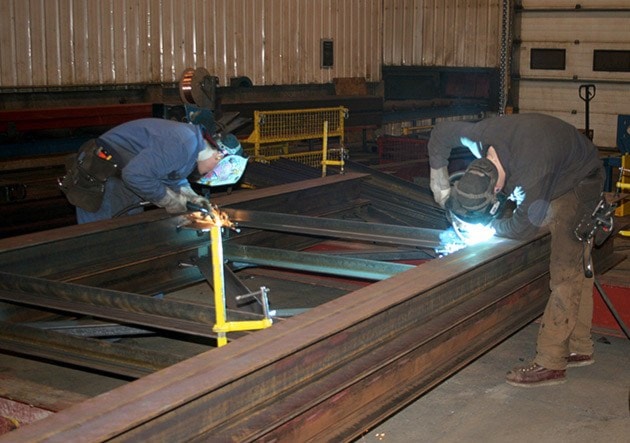Nechako Mechanical is celebrating seven years of no loss-time accidents, thanks to a work culture change introduced eight years ago.
Part of the construction conglomerate BID Group of Companies, the fabrication company in Vanderhoof underwent a change in its safety culture when Jody Volts, general manager of safety and environment of the BID Group, joined the company in 2007, said John Simoes, Nechako Mechanical’s fabrication manager of western Canada.
“When Jody came here eight years ago, we had a different story to tell,” Simoes said. “He brought in a lot of practices that a lot of us didn’t even think about.”
He added, “Or if we did think about it, we didn’t do anything about it.”
Though safety was not the company’s first priority, it was something that was drilled first into management, but wasn’t passed into our employees, Simoes explained.
“Now we do,” he said.
The new safety education includes videos on proper personal protection equipment, demonstrations of what could happened, and literature on hazards, Simoes said.
“We squeeze sausages into gloves and chop them in half,” he said. “If they do something stupid with a piece of steel, that’s what could happen if you put your fingers there.”
At the beginning of each shift, the crew has a morning toolbox meeting, where they talk about what’s being done in the shop, the item that’s being made, and any hazards that are associated with the task they are doing, Volts explained.
“Job hazard analysis (JHA), every employee has to fill one out at the beginning of every shift to analyze his work and what dangers are involved, how he’s going to eliminate or control that hazard before he goes to work,” he said, adding that the employee fills out another JHA if his task changes during the day. “Because he’s now in a different area, and different work and different hazards are associated with it.”
He added, “It’s all about self-awareness; look after yourselves, the employees around you.”
One of the two major injuries the company’s shop faced are eye-related, which have been largely eliminated with new procedures and the mandatory usage of safety glasses and face shields, Volts explained.
Another major injury in the shop, and will continue to be major, concerns employees’ hands and fingers, due to the nature of their work, he said.
“Because we’re a hands-on industry, we’re out there welding and cutting and picking up and moving steel,” he said.
For shop supervisor Matt MacLeod, working with job distribution, the new procedures are a wakeup call for the employee, he said.
“He has to take a second to look around, what his task is on the floor, and analyze and assess what he’s going to do,” MacLeod said. “And from there, hopefully with the information that we give them, and our safety toolbox meetings, they can pinpoint those hazards and assess them for themselves.”
For machine shop supervisor Jason Fitzpatrick, the largest difference brought in by the new procedures is making the usage of safety equipment mandatory, he said
“You have to wear your glasses, you have to use a shield, your gloves,” Fitzpatrick said. “It used to be a choice — you have to decide for yourself before — now you can’t use a grinder without a face shield.”
He added, “That reduces our injuries hugely.”
Leading apprenticeship program for a young workforce
The average age of Nechako Mechanical’s employees is about 23, Volts said.
He added, “We always talk about how young the work force is here.”
Though the change in the company’s safety culture wasn’t easy for all parties involved at the time, Nechako Mechanical’s predominantly young workforce made the transition less difficult, Simoes said.
“It’s easier to mould them into safety, than people that have been out doing poor safety practices all their lives,” he explained.
Twenty-three out of 57 employees on the shop floor are currently in various stages of the apprenticeship program, which began with one apprentice along with the company’s inception in 1989, Simoes said.
“We basically started out of necessity,” he said. “We didn’t have enough trades people in Vanderhoof, so we decided the best way is to get young people and we’ll train them and send them to school.”
First initiated by Brian Fehr, David Fehr, and Bob Derksen, who founded BID’s original construction firm, the apprenticeship program in Nechako Mechanical trained about 115 people over the years, out of 200 in total within BID, Simoes explained.
Young people who come looking for work and interested in an apprenticeship are given the choice of machining, fabricating, and millwright at the shop.
“If I don’t see the aptitude, we have a talk and say, ‘Look, I think you’re better suited to be [something else,]” he said.
While working, apprentices are sent to school in Prince George or Vancouver once or twice a year for “book stuff.”
With 6,600 hours of work experience, the four-year apprenticeship program provides employees with a Red Seal, an interprovincial and territorial standard for certified tradespeople.
Many graduates of the program, including machine shop supervisor Jason Fitzpatrick, started from high school and work as tradesmen at the company today, Simoes said.
